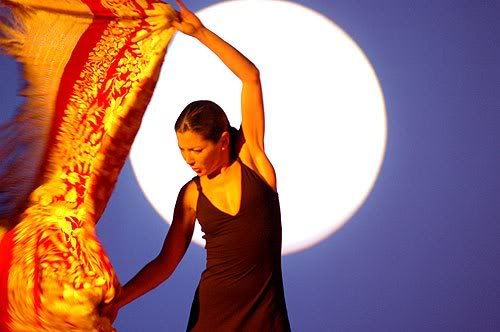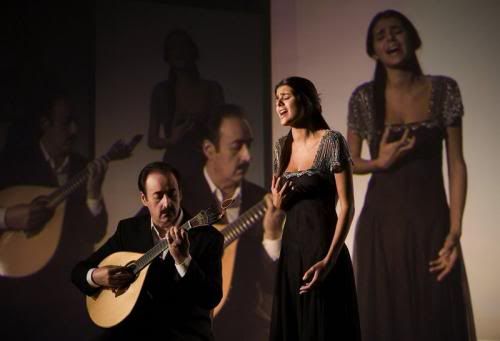
Fado is a type of traditional Portuguese music, still popular in its original mode as well as updated forms. In its combination of nostalgia, regret, romanticism, and sensuousness it occupies a similar place in Portuguese culture as flamenco does in Spain. Like flamenco, it echoes with lost times and lost loves. But fado is sweeter, more rounded, the accents less jabbing. Its exotic element comes from Africa and Brazil, rather than North Africa as in flamenco.
But fado is little known outside its own country (I italicize fado because, unlike flamenco, it has not entered the English language -- MS Word puts it on that platform of faint red dots that means, "Typo alert").
The director Carlos Saura has made a beautiful film featuring fado performers that could be a revelation to many who are unfamiliar with the art form. Indeed, although I have several prized CDs of fado singing, it quite expanded my appreciation.
This is a documentary -- wait, don't roll your eyeballs. It's nothing like those pseudo-intellectual music documentaries on PBS where you get a 90-second clip of the musician followed by five minutes of a talking head explaining what you've just seen and heard and why you should love it. Fados (the film) has no narration, no musicians struggling to conceptualize what they do, no politics except for a brief and relevant look back at the military dictatorship Portugal suffered under in the early 1970s. Saura trusts his audience's ability to appreciate his subject without editorializing, and bless him for that.
The movie contains about a dozen performing groups, and they're allowed to complete their songs full-length, without interruption. We see and hear how fado sounded in earlier generations; there's even a re-creation of a 19th-century performance. The basic instrumentation is a guitar and something whose name I don't know: it looks like a lute or a Middle Eastern oud, but sounds like a mandolin. In more modern arrangements, it is supplemented with a variety of others.
The movie gives us examples of how fado has blossomed to include bluesy, jazzy, marching, and other varieties. I could have done without the hip-hop version, which (un-musicological as I am) seems to me to violate the music's spirit, but it isn't awful.
Not surprisingly, fado has inspired choreographers to match the music's mood, and dancers accompany some of the performances, their art ranging from the ballet-like to the modern. I am not normally a dance fan, but I found most of this captivating with its svelte moves and colorful costumes.
Did I mention the singing? Well, I won't try to describe it. You have to hear (and see) the vocalists in Fados.
Saura has provided just the right degree of production values: enough for attractive and interesting settings, not so much as to be distracting. One unusual effect: some of the musicians are back-projected so you see them and their "ghosts" simultaneously. As a variation, there is a time delay so you see the performers in real time as well as what they were doing a second or two ago. It sounds contrived, and might be annoying if overworked, but Saura knows when enough is enough; he and his cinematographer show imagination and taste.
I've tried to give just enough description so that you will know if Fados is a film for you. It's available for rental, of course, from Netflix.
But fado is little known outside its own country (I italicize fado because, unlike flamenco, it has not entered the English language -- MS Word puts it on that platform of faint red dots that means, "Typo alert").
The director Carlos Saura has made a beautiful film featuring fado performers that could be a revelation to many who are unfamiliar with the art form. Indeed, although I have several prized CDs of fado singing, it quite expanded my appreciation.
This is a documentary -- wait, don't roll your eyeballs. It's nothing like those pseudo-intellectual music documentaries on PBS where you get a 90-second clip of the musician followed by five minutes of a talking head explaining what you've just seen and heard and why you should love it. Fados (the film) has no narration, no musicians struggling to conceptualize what they do, no politics except for a brief and relevant look back at the military dictatorship Portugal suffered under in the early 1970s. Saura trusts his audience's ability to appreciate his subject without editorializing, and bless him for that.
The movie contains about a dozen performing groups, and they're allowed to complete their songs full-length, without interruption. We see and hear how fado sounded in earlier generations; there's even a re-creation of a 19th-century performance. The basic instrumentation is a guitar and something whose name I don't know: it looks like a lute or a Middle Eastern oud, but sounds like a mandolin. In more modern arrangements, it is supplemented with a variety of others.
The movie gives us examples of how fado has blossomed to include bluesy, jazzy, marching, and other varieties. I could have done without the hip-hop version, which (un-musicological as I am) seems to me to violate the music's spirit, but it isn't awful.
Not surprisingly, fado has inspired choreographers to match the music's mood, and dancers accompany some of the performances, their art ranging from the ballet-like to the modern. I am not normally a dance fan, but I found most of this captivating with its svelte moves and colorful costumes.
Did I mention the singing? Well, I won't try to describe it. You have to hear (and see) the vocalists in Fados.
Saura has provided just the right degree of production values: enough for attractive and interesting settings, not so much as to be distracting. One unusual effect: some of the musicians are back-projected so you see them and their "ghosts" simultaneously. As a variation, there is a time delay so you see the performers in real time as well as what they were doing a second or two ago. It sounds contrived, and might be annoying if overworked, but Saura knows when enough is enough; he and his cinematographer show imagination and taste.
I've tried to give just enough description so that you will know if Fados is a film for you. It's available for rental, of course, from Netflix.




3 comments:
Rent?! Heck, I did the only decent thing and bought that, along with his Flamenco trilogy. Never say you never mad a difference!
I love fado and like your description of it. There are some wonderful dance movies out there so don't discount the pleasure that's to be found in them. "Tango Lesson" weaves story and dance together very artfully.
Just a suggestion.
made
Col. B,
Actually, "mad a difference" is my modus operandi! But thanks.
I have Saura's tango and flamenco films in my Netflix queue, and look forward to experiencing them.
Post a Comment